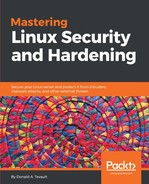SELinux is a free open source software project that was developed by the U.S. National Security Agency. While it can theoretically be installed on any Linux distro, the Red Hat-type distros are the only ones that come with it already set up and enabled. It uses code in Linux kernel modules, along with filesystem-extended attributes, to help ensure that only authorized users and processes can access either sensitive files or system resources. There are three ways in which SELinux can be used:
- It can help prevent intruders from exploiting a system
- It can be used to ensure that only users with the proper security clearance can access files that are labeled with a security classification
- In addition to MAC, SELinux can also be used as a type of role-based access control
In this chapter, I'll only be covering the first of these three uses because that is the most common way in which SELinux is used. There's also the fact that covering all three of these uses would require writing a whole book, which I don't have space to do here.
So how can SELinux benefit the busy systems administrator? Well, you might remember when a few years ago, news about the Shellshock bug hit the world's headlines. Essentially, Shellshock was a bug in the Bash shell that allowed intruders to break into a system and to exploit it by gaining root privileges. For systems that were running SELinux, it was still possible for the bad guys to break in, but SELinux would have prevented them from successfully running their exploits.
SELinux is also yet another mechanism that can help protect data in users' home directories. If you have a machine that's set up as a Network File System server, a Samba server, or a web server, SELinux will prevent those daemons from accessing users' home directories, unless you explicitly configure SELinux to allow that behavior.
On web servers, you can use SELinux to prevent the execution of malicious CGI scripts or PHP scripts. If you don't need for your server to run CGI or PHP scripts, you can disable them in SELinux.
With older versions of Docker and without Mandatory Access Control, it was trivially easy for a normal user to break out of a Docker container and gain root-level access to the host machine. Although Docker security has since improved, SELinux is still a useful tool for hardening servers that run Docker containers.
So now, you're likely thinking that everyone would use such a great tool, right? Sadly, that's not the case. In its beginning, SELinux got a reputation for being difficult to work with, and many administrators would just disable it. In fact, a lot of tutorials you see on the web or on YouTube have disable SELinux as the first step. In this section, I'd like to show you that things have improved and that SELinux no longer deserves its bad reputation.
